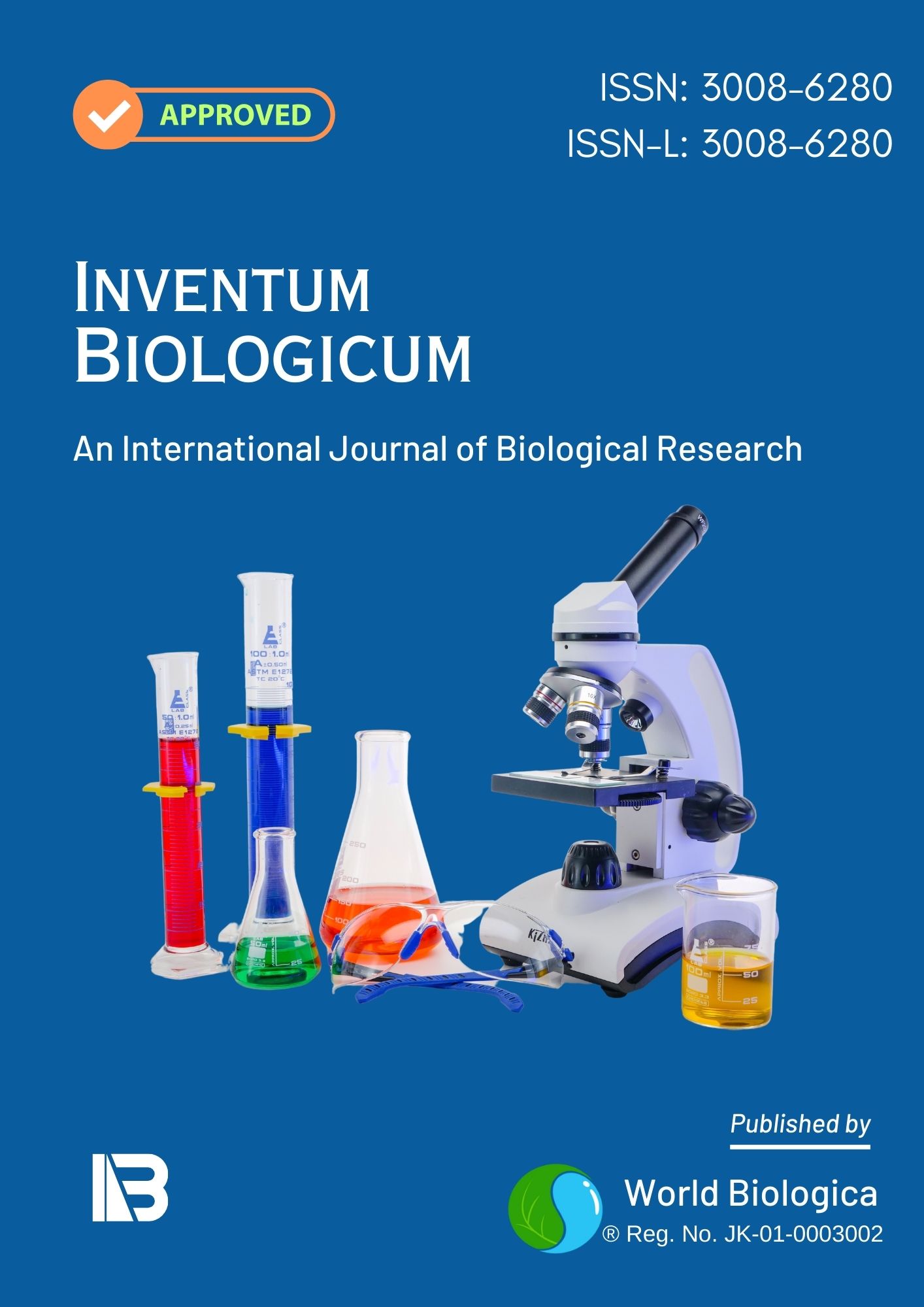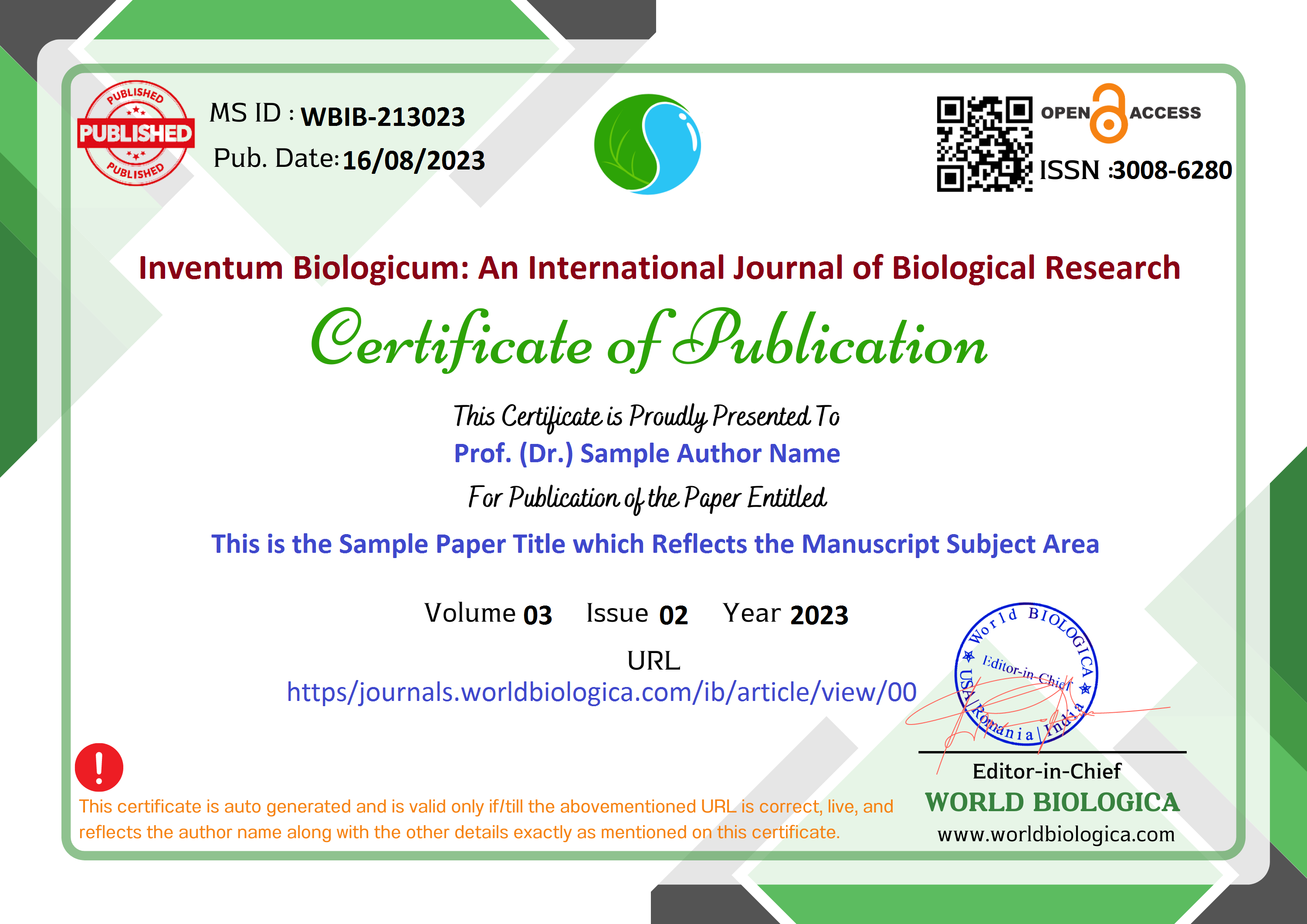16S rRNA Gene Sequencing and Phylogeny Analysis Revealed the Presence of Beneficial Bacteria in the Rhizosphere of Eggplant (Solanum melongena) from Malda (West Bengal, India)
Keywords:
Rhizosphere soil, Eggplant, Lactic acid bacteria, Limosilactobacillus fermentum, Bifidobacterium animalis subsp. lactisAbstract
Lactic acid bacteria have been used in agricultural practices with promising potential as soil health-promoting microorganisms. Isolation of lactic acid bacteria from the rhizosphere soil of various crops including brinjal (eggplant), Solanum melongena has been reported from different parts of the world. No such reports are available in our region (Malda, India). In this study, we have isolated and characterized lactic acid bacteria from Solanum melongena rhizosphere. The rhizosphere soils from the eggplant cultivars (Jhiloria, Chandtara, Jotshna) were processed microbiologically, and three lactic acid bacteria were isolated. The16S rRNA gene sequencing and phylogeny analysis confirmed the identities of lactic acid bacteria as Limosilactobacillus fermentum isolated from the rhizosphere of Jhiloria and Chandtara varieties of eggplant, while the isolate from the rhizosphere of the Jotshna variety of eggplant was identified as Bifidobacterium animalis subsp. lactis. Thus, the presence of beneficial bacteria (Limosilactobacillus fermentum and Bifidobacterium animalis subsp. lactis) in the rhizosphere of crop plants might help improve soil health thereby enhancing crop production.
Downloads
References
Alessandri, G., Ossiprandi, M. C., Ventura, M., & Van Sinderen, D. (2021). Protocol to select bifidobacteria from fecal and environmental samples. In D. Van Sinderen & M. Ventura (Eds.), Bifidobacteria (Vol. 2278, pp. 61–70). Springer US. https://doi.org/10.1007/978-1-0716-1274-3_6
Altschul, S. F., Gish, W., Miller, W., Myers, E. W., & Lipman, D. J. (1990). Basic local alignment search tool. Journal of Molecular Biology, 215(3), 403–410. https://doi.org/10.1016/S0022-2836(05)80360-2
Argentini, C., Lugli, G. A., Tarracchini, C., Fontana, F., Mancabelli, L., Viappiani, A., Anzalone, R., Angelini, L., Alessandri, G., Bianchi, M. G., Taurino, G., Bussolati, O., Milani, C., Van Sinderen, D., Turroni, F., & Ventura, M. (2024). Ecology- and genome-based identification of the Bifidobacterium adolescentis prototype of the healthy human gut microbiota. Applied and Environmental Microbiology, 90(2), e02014-23. https://doi.org/10.1128/aem.02014-23
Duranti, S., Longhi, G., Ventura, M., Van Sinderen, D., & Turroni, F. (2020). Exploring the ecology of bifidobacteria and their genetic adaptation to the mammalian gut. Microorganisms, 9(1), 8. https://doi.org/10.3390/microorganisms9010008
Hadadji, M., Benama, R., Saidi, N., Henni, D. E., Kihal, M. (2005). Identification of cultivable Bifidobacterium species isolated from breast-fed infants feces in West-Algeria. African Journal of Biotechnology, 4, 422-430.
Halder, D., Mandal, M., Chatterjee, S., Pal, N., & Mandal, S. (2017). Indigenous probiotic lactobacillus isolates presenting antibiotic like activity against human pathogenic bacteria. Biomedicines, 5(2), 31. https://doi.org/10.3390/biomedicines5020031
Hiranmayee, G., Marik, D., Sadhukhan, A., & Reddy, G. S. (2023). Isolation of plant growth-promoting rhizobacteria from the agricultural fields of Tattiannaram, Telangana. Journal of Genetic Engineering and Biotechnology, 21(1), 159. https://doi.org/10.1186/s43141-023-00615-5
Hirpara, K. R., Hinsu, A. T., & Kothari, R. K. (2024). Metagenomic evaluation of peanut rhizosphere microbiome from the farms of Saurashtra regions of Gujarat, India. Scientific Reports, 14(1), 10525. https://doi.org/10.1038/s41598-024-61343-5
Kumar, S., Stecher, G., Li, M., Knyaz, C., & Tamura, K. (2018). Mega x: Molecular evolutionary genetics analysis across computing platforms. Molecular Biology and Evolution, 35(6), 1547–1549. https://doi.org/10.1093/molbev/msy096
Lamendella, R., Domingo, J. W. S., Kelty, C., & Oerther, D. B. (2008). Bifidobacteria in feces and environmental waters. Applied and Environmental Microbiology, 74(3), 575–584. https://doi.org/10.1128/AEM.01221-07
Mackie, T. J., Collee, J. G., & McCartney, J. E. (2007). Mackie and McCartney practical medical microbiology (14th ed.). Elsevier.
Mendes, R., Garbeva, P., & Raaijmakers, J. M. (2013). The rhizosphere microbiome: Significance of plant beneficial, plant pathogenic, and human pathogenic microorganisms. FEMS Microbiology Reviews, 37(5), 634–663. https://doi.org/10.1111/1574-6976.12028
Murindangabo, Y. T., Kopecký, M., Perná, K., Nguyen, T. G., Konvalina, P., & Kavková, M. (2023). Prominent use of lactic acid bacteria in soil-plant systems. Applied Soil Ecology, 189, 104955. https://doi.org/10.1016/j.apsoil.2023.104955
Raman, J., Kim, J.-S., Choi, K. R., Eun, H., Yang, D., Ko, Y.-J., & Kim, S.-J. (2022). Application of lactic acid bacteria (Lab) in sustainable agriculture: Advantages and limitations. International Journal of Molecular Sciences, 23(14), 7784. https://doi.org/10.3390/ijms23147784
Rodriguez, C. I., & Martiny, J. B. H. (2020). Evolutionary relationships among bifidobacteria and their hosts and environments. BMC Genomics, 21(1), 26. https://doi.org/10.1186/s12864-019-6435-1
Roy, S., & Mandal, S. (2024). Lactiplantibacillus plantarum isolates from natural honey (Malda, india): Probiotic potentiality and antibacterial activity analysis by in vitro methods. Food and Humanity, 3, 100348. https://doi.org/10.1016/j.foohum.2024.100348
Sanders, M. E., Merenstein, D., Merrifield, C. A., & Hutkins, R. (2018). Probiotics for human use. Nutrition Bulletin, 43(3), 212–225. https://doi.org/10.1111/nbu.12334
Singhal, N., Singh, N. S., Mohanty, S., Kumar, M., & Virdi, J. S. (2021). Rhizospheric Lactobacillus plantarum (Lactiplantibacillus plantarum) strains exhibit bile salt hydrolysis, hypocholestrolemic and probiotic
capabilities in vitro. Scientific Reports, 11(1), 15288. https://doi.org/10.1038/s41598-021-94776-3
Sircar, B., & Mandal, S. (2023). Exploring the probiotic potentiality and antibacterial activity of idli batter isolates of lactic acid bacteria from West Bengal, India. Future Journal of Pharmaceutical Sciences, 9(1), 54. https://doi.org/10.1186/s43094-023-00506-z
Stephen, J. M., & Saleh, A. M. (2023). Homofermentative Lactobacilli isolated from organic sources exhibit potential ability of lactic acid production. Frontiers in Microbiology, 14, 1297036. https://doi.org/10.3389/fmicb.2023.1297036
Thakur, M., Deshpande, H. W., & Bhate, M.A. (2017). Isolation and identification of lactic acid bacteria and their exploration in non-dairy probiotic drink. International Journal of Current Microbiology and Applied Sciences, 6(4), 1023–1030. https://doi.org/10.20546/ijcmas.2017.604.127
Wieczorska, K., Stolarek, M., & Stec, R. (2020). The role of the gut microbiome in colorectal cancer: Where are we? Where are we going? Clinical Colorectal Cancer, 19(1), 5–12. https://doi.org/10.1016/j.clcc.2019.07.006
Downloads
Published
How to Cite
Issue
Section
License
Copyright (c) 2024 Inventum Biologicum: An International Journal of Biological Research

This work is licensed under a Creative Commons Attribution-NonCommercial-NoDerivatives 4.0 International License.













